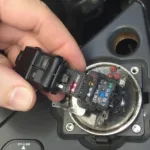The OBD2 pin out is the key to unlocking your car’s diagnostic data. This guide will delve into the intricacies of the OBD2 port, explaining its function, the meaning of each pin, and how you can utilize this knowledge for vehicle maintenance and troubleshooting.
Decoding the OBD2 Pin Out
The OBD2 port, typically located under the driver’s side dashboard, is a standardized 16-pin connector. Each pin within this connector has a specific function, enabling communication between your vehicle’s onboard computer and diagnostic tools. Understanding the obd2 pin out empowers you to diagnose car problems, monitor performance, and even customize certain vehicle settings.
What Does Each OBD2 Pin Do?
The 16 pins of the OBD2 connector are arranged in two rows of eight. While some pins are standardized across all vehicles, others are manufacturer-specific. Here’s a breakdown of the common pin functions:
- Pin 1: Not Used
- Pin 2: J1850 Bus+ (Used by some Ford and GM vehicles)
- Pin 3: Not Used
- Pin 4: Chassis Ground
- Pin 5: Signal Ground
- Pin 6: CAN High (Controller Area Network)
- Pin 7: ISO 9141-2 K-Line (Used by some Chrysler, European, and Asian vehicles)
- Pin 8: Not Used
- Pin 9: Not Used
- Pin 10: J1850 Bus- (Used by some Ford and GM vehicles)
- Pin 11: Not Used
- Pin 12: Not Used
- Pin 13: Not Used
- Pin 14: CAN Low (Controller Area Network)
- Pin 15: ISO 9141-2 L-Line (Used by some Chrysler, European, and Asian vehicles)
- Pin 16: Battery Power
Why is Knowing the OBD2 Pin Out Important?
Understanding the obd2 pin out power is crucial for several reasons:
- Troubleshooting: By connecting a scan tool to the appropriate pins, you can retrieve diagnostic trouble codes (DTCs) that pinpoint the source of vehicle malfunctions.
- Monitoring Performance: Access real-time data from various sensors, including engine speed, coolant temperature, and fuel pressure. This information helps track vehicle performance and identify potential issues before they escalate.
- Customization: Certain vehicle settings, such as lighting and door locks, can be adjusted through the OBD2 port.
Common Uses of the OBD2 Pin Out
Here are some practical scenarios where knowing the obd2 pin out is beneficial:
- Checking Engine Light: Retrieve DTCs to diagnose the cause of the check engine light.
- Emissions Testing: Verify that the vehicle’s emissions systems are functioning correctly.
- Performance Tuning: Monitor and adjust engine parameters for optimal performance.
- Clearing Trouble Codes: After repairing a problem, clear the DTCs to reset the check engine light.
2000 hyundai tiburon obd2 pin out
Troubleshooting with the OBD2 Pin Out
Imagine your car isn’t starting. Using an OBD2 scanner and understanding the 2001 subaru legacy 2.5 sohc obd2 pin out can help you pinpoint whether the issue is related to the fuel system, ignition system, or another component. This saves you time and potentially costly repairs.
“Knowing the obd2 pin out is like having a direct line to your car’s brain,” says automotive expert, Dr. Emily Carter. “It allows you to understand what’s happening under the hood and make informed decisions about maintenance and repairs.”
 Using an OBD2 Scanner to Diagnose Car Problems
Using an OBD2 Scanner to Diagnose Car Problems
Conclusion
The obd2 pin out is an essential piece of knowledge for any car owner or enthusiast. Understanding how each pin functions can empower you to diagnose problems, monitor performance, and customize your vehicle. By leveraging this information, you can take control of your car’s maintenance and ensure its optimal performance. 2014 tacoma obd2 pin out
Need support? Contact us via WhatsApp: +1(641)206-8880, Email: [email protected] or visit us at 789 Elm Street, San Francisco, CA 94102, USA. Our customer service team is available 24/7.

